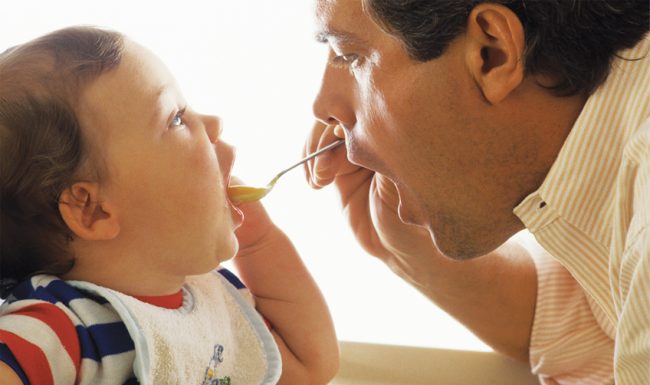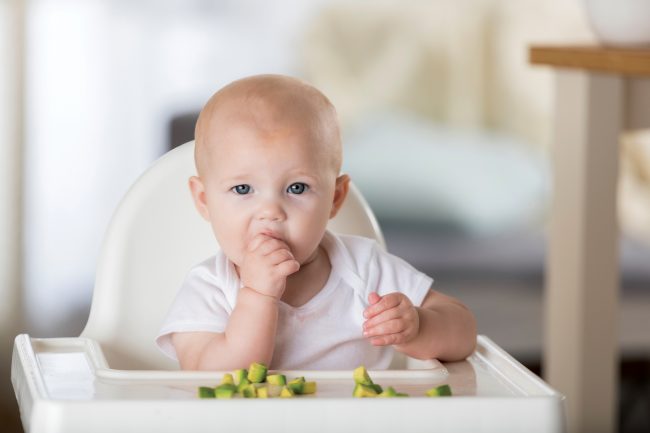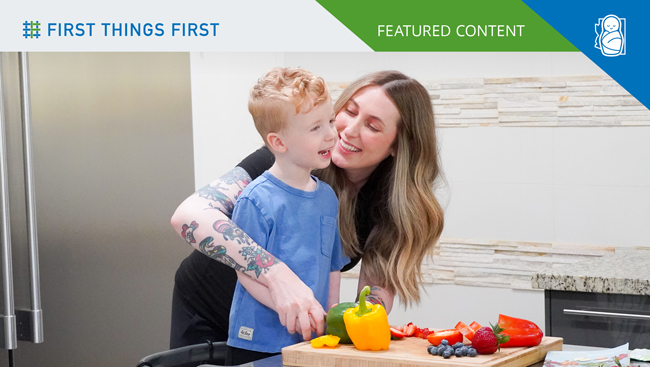The first few bites of solid food are a big milestone. New flavors, textures and skills—it’s a whole new adventure for your baby and for you. And don’t worry—you’re not alone in figuring it out.

When Can My Baby Start Solids
Most babies are ready between 6 and 8 months old. But, every baby is different. Breast milk or formula should still be their main food, but now you can slowly start introducing soft, mashed foods. Your baby may be ready if:
- They can hold their head up and sit up with a little support.
- They’re around double their birth weight (usually 13+ lbs).
- They swallow food instead of spitting it out.
- They show interest when you eat, reach for your food or open their mouth.
First Foods (6 to 8 Months)
Start small—just a few teaspoons of mashed or pureed food once a day. Most parents begin with baby cereal mixed with breast milk or formula, but mashed veggies, fruits or meats are great options, too.
Pro Tip: Begin and end with breast milk or formula so your baby still gets what they need.
Within a couple of months, you can offer more variety. Ask your doctor about starting smooth peanut butter or peanut puffs to help reduce allergy risk.
Signs Your Baby Is Full
- Babies are actually pretty good at telling you when they’ve had enough—no pressure to have them finish what’s on the spoon. Watch for:
- Turning their head away
- Spitting food out
- Fussing or pushing the spoon away

Finger Foods, Cups & Self-Feeding (9 to 12 Months)
Now it gets fun—and messy. At this stage, your baby can start eating soft foods that they can pick up and mash with their gums. You may offer breast milk or formula with meals (Skip cow’s milk until after age 1).
- Soft-cooked veggies and fruits
- Small bits of tofu, cheese or scrambled eggs
- Tiny pieces of soft meat, beans or fish
Let your baby join family mealtimes, even if they just play with their food at first. That’s part of learning. And, it helps develop and improve their sensory awareness and motor skills!
Weaning Off Breast or Bottle
There’s no one-size-fits-all approach to weaning. Do what works best for you and your baby. After weaning, babies and young children should drink plain water or milk. These are the healthiest drinks for children of all ages.
- If breastfeeding, aim to continue for at least a year. Slowly drop feedings based on your baby’s interest.
- If bottle-feeding, begin offering a sippy cup around 6 months and try to stop bottles by 12 to 18 months.
Pro Tip: No bottles in bed or carried around during the day—it can cause tooth decay.
Feeding Your Baby Safely
- Wash hands and baby gear before feeding.
- Test food temperature before serving.
- Cook fruits and veggies, unless they’re soft (like bananas).
- Never put cereal in a bottle—it’s a choking risk.
- Don’t give babies honey before their first birthday—it can cause illness.
Chocking Hazards to Avoid
Your baby needs to be watched every time they eat. They might not make noise if they choke, so be nearby. To reduce choking risk:
- Cut foods into half-inch pieces.
- Cut grapes, hot dogs and cherry tomatoes into strips, not rounds.
- Skip hard foods like nuts, popcorn and raw carrots.
- Avoid sticky or tough foods like dried fruit or big chunks of meat.


